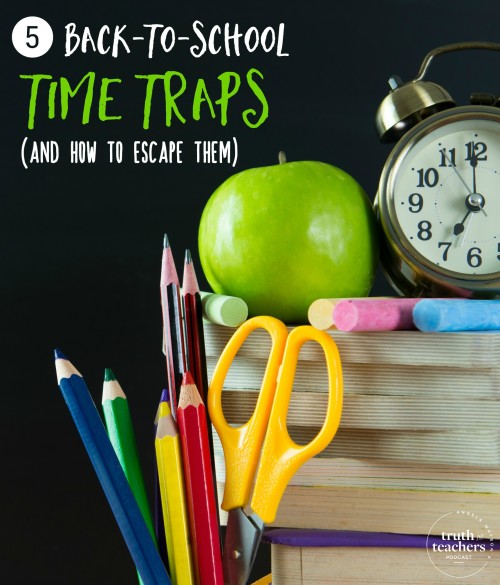At this time of year, your to-do list is going to be a mile long, and you’re going to be working a lot of hours trying to get good systems in place for your new group of students. If you are feeling overwhelmed by all that needs to be done and exhausted not only by the long hours but also the physical labor of rearranging and setting up a classroom, please know that this is very normal, and it will get better. I tended to work 70-hour weeks or more during those first two weeks of school–I wanted to do things right the first time and from the start, rather than having to go back and finish or redo things later. I considered my long hours at back-to-school as an investment of time–doing things during those first few weeks that would create more time for me later.
However, there are things you might get sucked into doing this time of year that waste time, or actually create more work for you in the long run. These are five back-to-school time traps that you want to avoid.
Want to listen to this post instead of read?
TRAP #1: Doing double work by beginning tasks too soon
ESCAPE: Give yourself permission to wait to do certain tasks IF you’re going to create double work by beginning now. For example, labeling classroom items with students’ names and planning your exact desk arrangement too soon before school starts could cause you to have to re-do those tasks every time your class list changes. I remember getting my desks set up for exactly 23 kids, and then having to rethink for 26, then for 24, then for 28…I should have just put the desks approximately where I wanted them, and then waited until the day before students started to create my final arrangement and put desk tags on. And even then, I’d need to have blank tags and extra desks ready so that all the changes to the roster those first few weeks of school wouldn’t throw me off guard.
The idea is to avoid making things perfect right now, especially when inevitable changes that crop up are going to undo your perfect system and create frustration. Focus on your biggest priority tasks for now, and give yourself permission to not only wait to do stuff that it’s not yet time for, but to leave some things partially complete until you have all the needed information.
TRAP #2: Chatting with coworkers instead of getting work done
ESCAPE: On your first official day back, plan to do a little less work so you can ease into the school year and have time to catch up with coworkers you haven’t seen in a few weeks. After that, set a designated time to be social: at lunch, or breakfast once a week in a colleague’s room just before your contracted hours begin, or bi-weekly happy hour with your team, etc.
Then, do not allow yourself to get distracted by chit chat during your planning time. To avoid hurt feelings, make it sound like the problem is with you, not your coworkers. Tell them, “This year, I’m really trying to focus on work when I’m at school so I can get out of here and relax in the evenings. If you see me come into your room just to hang out and chat, please remind me I told you this so I can stop myself and get back on track!”
And can I also suggest that you be selective about who you spend your time with? You want to be friendly and cordial to everyone, but you don’t need to run through a 20-minute recap of the summer with every single person who teaches on your floor. Avoid those coworkers who just want to anticipate problems and complain about how much they’re dreading the new school year–their negativity will be a drain on your enthusiasm. Be polite, but look for the first opportunity to say, “I know you have so much to do–I won’t hold you up. I’ll see you at the meeting later!” and keep it moving.

TRAP #3: Long conversations and constant messages from students’ parents
ESCAPE: Create designated office hours in which you are available for conferences, returning parent phone calls, and responding to parent emails. It’s only natural for parents to want personal conversations with you about their child and special family situations, and everyone benefits when the teacher and parents are on the same page. But you want to batch these tasks as much as possible, rather than doing them all throughout the day, every single day. This will enable you to really focus on the conversations and connections, and keep you from feeling like all you do is email parents.
Try to funnel the majority of your communication through one channel (such as a parent communication app like Bloomz, Class Tag, Remind or ClassDojo Messenger) so that you don’t have to sort through voicemails, email, handwritten notes, text messages, and so on. The great thing about these free apps is that they still allow parents to communicate in a way that makes sense for them: they can email you or text you, for example, but you receive the messages within the app, within this single platform, so all the messages are going into and coming out of one place. It’s about simplifying and streamlining.
When a parent approaches you for the 10th time for an impromptu conference on something insignificant, say, “I would love to talk about this, and I want to give you my full attention when we do. Right now I have some other tasks to take care of, so would you like to schedule an appointment to come in or call at ___ [a time during your office hours]?” If you find it’s better to handle the situation on the spot but still get trapped into an overly long conversation, say, “I would love to keep talking with you about this, but I’m sure you have so many other things to do right now and I don’t want to hold you up. Do you want to schedule a time to continue this later, or do you feel like we’re on the same page and ready to move forward with our plan?”
TRAP #4: Wasting time in meetings
ESCAPE: Back-to-school time is just saturated with unnecessary meetings for most of us, and you can make suggestions that your school use shared documents and files to communicate in place of some meetings. You can also push for a move toward “flipped professional development” models (in which you watch or read the training yourself at your convenience and use meetings as necessary for a short discussion afterward). When meetings ARE truly necessary, work to create agendas that start and end at specific times and have clear actionable outcomes that are expected (so if you reach a resolution before the meeting is over, you can create closure and end early.)
When you find yourself stuck in a pointless meeting that can’t be avoided, use that time to think back on what you’ve accomplished that day and how much you’ve gotten done. This is the exact opposite of what will happen intuitively–you’ll be tempted to sit there and get frustrated about how much you need to be getting done. Instead, take deep breaths and reflect on all the progress you’ve made toward your goals, and make a mental list of all the great things that have happened that you’re proud of.
This can completely transform your mood in just a minute or two, which means that you won’t lose more time after the meeting by complaining about it or wasting time on social media because now you’re too irritated and distracted to get any real work done. Resolve to leave every meeting in a productive, positive mindset so that you can get out of there ready to move on with your day. You have the power to do that, no one can make you feel a certain way without your permission, so don’t let anyone take that power away!
TRAP #5: Obsessing over decorating your classroom (and other things that don’t matter)
ESCAPE: Focus on designing a classroom for productivity and learning rather than appearance. Organize your classroom so you (and students) can find things easily and put them back where they belong immediately after use. Create organizational systems for yourself that are so simple, you can even use them while students are in the room (instead of staying after school to put away piles of stuff.)
When setting up the rest of your classroom, focus on usability for students, and design your classroom so that your systems are intuitive for them. The easier it is for students to figure out how to follow your procedures and keep the classroom organized, the fewer reminders and consequences you’ll have to give.

So instead of wasting time with these five traps, use your time to focus on getting your classroom procedures in place so routine tasks are automated and delegated to students. Plan how you want your classroom to run and how you will teach expectations to students.
If school has started for you already, resist the urge to do basic management tasks yourself because it’s easier than teaching students how to do them. Empower kids to take responsibility for how the classroom runs and their own learning. Focus on connecting with your students and building a rapport with them, and creating the type of classroom community that makes kids feel supported and welcome and ready to learn.
I know it can be difficult to focus on what’s most important when they’re so much on your plate, but remember that YOU are ultimately in control of your choices about how your time is spent. Don’t focus on the chunks of time you have no control over: focus on how you will accomplish your biggest priorities during the rest of the day.
Be strict with yourself and ask, What am I choosing to say NO to in order to say YES to spending hours on this task? What else could I be doing with my time that would create more time for me later?
Don’t beat yourself up when you get sucked into things that don’t really matter. Just focus on making a better choice here in this moment, and then again in the next. As we talk about in the 40 Hour Teacher Workweek Club, productivity is often about celebrating small bits of progress, and being okay with taking two steps forward and one step back. Release yourself from the pressure to be perfect, and focus instead on awareness of how you use your time: what feels valuable and productive, what doesn’t. I think you’ll find that just this awareness helps creates an intentionality in your life where you learn to make better decisions slowly over time.

Be intentional about how you use your time. A river with no boundaries creates a swamp. Click To Tweet
![]() See blog posts/transcripts for all episodes
See blog posts/transcripts for all episodes
The Truth for Teachers Podcast
Our weekly audio podcast is one of the top K-12 broadcasts in the world, featuring our writers collective and tons of practical, energizing ideas. Support our work by subscribing in your favorite podcast app–everything is free!
Explore all podcast episodes
Angela Watson
Founder and Writer
Discussion
Leave a Reply
OR

Join our
community
of educators
If you are a teacher who is interested in contributing to the Truth for Teachers website, please click here for more information.



















Thanks for these great tips! I always enjoy reading your posts.
Very good advice! Already fell into a coupe of the mentioned pits, but the blog has inspired me to make better time choices.
Terrific, succinct, honest ….
I’m starting my 42nd year and I wish, wish, wish you’d been around a long time ago. Lucky for the new teachers starting out and even for us old teachers heading out!
I’m starting my 41st and I am determined to make this the most efficient…because it’s my last.
41+ years? You are rock stars!
Thank you! This was very helpful!!!
Great information! Thanks so much!